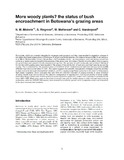More woody plants? the status of bush encroachment in Botswana's grazing areas
Date
2002Author
Moleele, N.M.
Ringrose, S.
Matheson, W.
Vanderpost, C.
Publisher
ScienceDirect, www.sciencedirect.comType
Published ArticleMetadata
Show full item recordAbstract
the cattle-dominated grazing areas of Botswana. Bush encroachment species – for instance Acacia tortilis, A. erubescens,
A. mellifera, Dichrostachys cinerea, Grewia flava, and Terminalia sericea –are increasing in cover and density around foci points (e.g. water points and kraals) at the expense of the grass cover. A number of factors have the effect of encouraging the germination and survival of bush encroachment species. The practice of cattle husbandry and continual shifting of foci points within grazing areas have resulted in the spread of the distribution of bush encroachment species across the
country. This is evidenced by the potential extent of 37 000 km2 (6 4% of Botswana) of darkened and near infrared (NIR)
reflective bush encroached areas in 1994. This paper suggests that specific management strategies should be adopted to help overcome the bush encroachment problem, which is causing a significant reduction in the extent of Botswana’s
high quality rangeland. These strategies may vary from the enforced reduction of grazing intensity in areas identified
as being heavily bush encroached to the selective management of opportunistic (communal) grazing in better quality
predominantly grassland areas. Further work is however required to update this analysis and especially to consider trends
since 1994–1995. While some work on the extent of woody cover and the further causes of bush encroachment is being undertaken under the SAFARI2000 project, more research is needed in specific areas to pinpoint causes and responses
to the bush encroachment problem.
Collections
- Research articles (ORI) [270]

